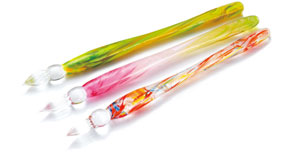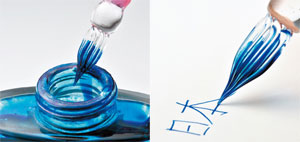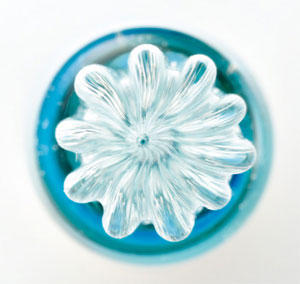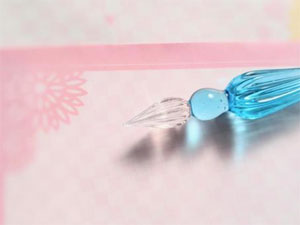

Gorgeous Glass Pens
|
Stationery made in Japan has always been widely appreciated for both aesthetic and practical reasons. Ranging from washi tape to pens with erasable ink and stapleless staplers, people from all over the world enjoy using Japanese stationery. For the past few years, glass pens have been gaining attention.
Glass pens originated in Japan during the late Meiji era. It is said to have been created by a wind chime craftsman by the name of Sadajiro Sasaki. Back then, the glass pen was not in demand as it was inconvenient to carry something that was fragile. Only the nib was made of glass. It was only towards the end of the Showa era, that eventually the body was also made of glass, integrating both the nib and barrel. The techniques employed by Sadajiro Sasaki are apparently still used today in a glass pen factory in Taito Ward, Tokyo. There is renewed attention in glass pens in recent years due to its unique beauty and practicality as a traditional craft. It glides over the paper smoothly in any direction and retains the ink well. Capillary actions allows the ink to be drawn into the pen, and if the nib is filled up to one-third full, it is sufficient to write one postcard. Moreover, unlike a fountain pen, you can easily switch between different ink colours by simply rinsing the nib in water and wiping it dry. The fragile nature of the pen adds to its transient beauty too. Each pen is made manually by a craftsman, with a pen’s nib having typically eight to twelve grooves. Hence, no two pens are the same shape and colours. In particular, a unique pattern is created when twisting, contracting and extending the glass rod over the burning flame. It is crucial to control the flame, as even a 1mm difference in the flame’s width can impact the result. The most challenging step is to determine the centre of the nib, and form grooves all the way to the tip. The process almost looks like stretching a bar of starch syrup, though the nib can be as thin as hair at its narrowest point. If not done properly, the pen cannot be used at all. Apparently, it requires about 10 years to master how to create a satisfactory nib. There are generally three variations of pen nibs: fine, medium, and bold. Nowadays, glass pens with thicker nibs are popular as the ink’s colour can be seen when writing. If you are looking for a one-of-a-kind souvenir from Japan, why not consider a glass pen? This special stationery may end up being a writing companion for life. |
 © Hongo Jin  © Hongo Jin  © Hongo Jin  © photoAC |
Resources
|
“Japan-Original, Beautiful Writing Implements, So Easy To Use – Glass Pens”. 2022. https://web-japan.org/niponica/niponica33/en/feature/feature09.html. “Traditional Craftsmaker – Glass Pens”. 2020. Taito City. Accessed 14 November. https://craft.city.taito.lg.jp/en/craftsmaker/3761/. Arai, Yoshiaski. 2021. “They break easily, but glass pens are the write way to go”. The Asahi Shimbun. https://www.asahi.com/ajw/articles/14344247. Matsumoto, Sawa. 2021. “Elegant glass pens forged for practical use”. The Japan News – by The Yomiuri Shimbun. https://japannews.yomiuri.co.jp/culture/art/20210422-67749/. “Art of Glass”. 2023. NHK World-Japan. Accessed 14 November. https://www3.nhk.or.jp/nhkworld/en/ondemand/video/9999f16/ . |
|
Japan Creative Centre 4 Nassim Road, Singapore 258372 +65 6737 0434 / jcc@sn.mofa.go.jp https://www.sg.emb-japan.go.jp/JCC/ Nearest parking at Orchard Hotel & Delphi Orchard |
 |